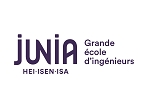Establishment
Language of instruction
French, English
Teaching content
MB-ST
Training officer(s)
AM.KOKOSY, G.TAGNE
Stakeholder(s)
G.TAGNE, Santiago BRAGAGNOLO
Présentation
Prerequisite
Basic knowledge on modeling and control
Basic knowledge on Network
Programming skills: C, C++
Basic knowledge on Network
Programming skills: C, C++
Goal
Expected skills : 32 (322/323), 34 (342/343), 112 (1121/1122)
In this course, you will learn to implement perception, localisation, navigation and communication techniques in order to design an autonomous robotic system. This one needs to interact with its environment as well as with the other fixed or mobile entities. Moreover, the training will focus on the implementation of a vision based control, navigation control algorithms (e.g. SLAM) and communication architectures (ROS, MQTT). Application cases will be presented by robotics companies to illustrate the use of these techniques on use cases. An awareness of industrialization and the constraints that it induces in the design of robotic systems will also be addressed.
At the end of this course, the student should be able to:
Design and develop an autonomous robotic system by choosing the appropriate navigation algorithms, taking into account the industrialization constraints
Know how to design the robot's communication architecture and software
Know how to implement a vision referenced control algorithm on a robot
Know how to implement a localisation and navigation algorithm (e.g. SLAM) on a robot using ROS
Some of the pedagogical approaches in this module allow you to work on transversal skills such as project management, report writing and oral communication.
In this course, you will learn to implement perception, localisation, navigation and communication techniques in order to design an autonomous robotic system. This one needs to interact with its environment as well as with the other fixed or mobile entities. Moreover, the training will focus on the implementation of a vision based control, navigation control algorithms (e.g. SLAM) and communication architectures (ROS, MQTT). Application cases will be presented by robotics companies to illustrate the use of these techniques on use cases. An awareness of industrialization and the constraints that it induces in the design of robotic systems will also be addressed.
At the end of this course, the student should be able to:
Design and develop an autonomous robotic system by choosing the appropriate navigation algorithms, taking into account the industrialization constraints
Know how to design the robot's communication architecture and software
Know how to implement a vision referenced control algorithm on a robot
Know how to implement a localisation and navigation algorithm (e.g. SLAM) on a robot using ROS
Some of the pedagogical approaches in this module allow you to work on transversal skills such as project management, report writing and oral communication.
Presentation
This module is the complement of the Intelligent Robotic Systems module. It focuses more particularly on the notions of communication (between entities of the robotic system as well as other entities of its environment) and autonomous navigation.
It deals with several themes:
Strategies for autonomous navigation
Communication protocols and software architectures
ROS : Robot Operating System
Application cases presented by robotics companies
It deals with several themes:
Strategies for autonomous navigation
Communication protocols and software architectures
ROS : Robot Operating System
Application cases presented by robotics companies
Modalités
Forms of instruction
Cours, Travaux pratiques, projets de mise en situation
Organization
| Type | Amount of time | Comment | |
|---|---|---|---|
| Face to face | |||
| Lectures - face to face | 10,00 | ||
| Lab | 14,00 | ||
| Overall student workload | 24,00 | ||
Evaluation
| Control type | Duration | Amount | Weighting |
|---|---|---|---|
| Final Exam | |||
| Written test | 1,00 | 1 | 30,00 |
| Continuous assessment | |||
| Lab grade | 20,00 | 2 | 70,00 |
| TOTAL | 100,00 | ||






